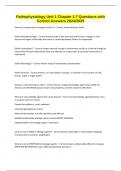Exam (elaborations)
Pathophysiology Unit 1 Chapter 1-7 Questions with Correct Answers 2024/2025
- Course
- Institution
Pathophysiology Unit 1 Chapter 1-7 Questions with Correct Answers 2024/2025 Failure to compensate to changes results in? - Correct Answer disease, death Define Pathophysiology? - Correct Answer study of the structural and function changes in cells, tissues and organs of the body that cause or c...
[Show more]



